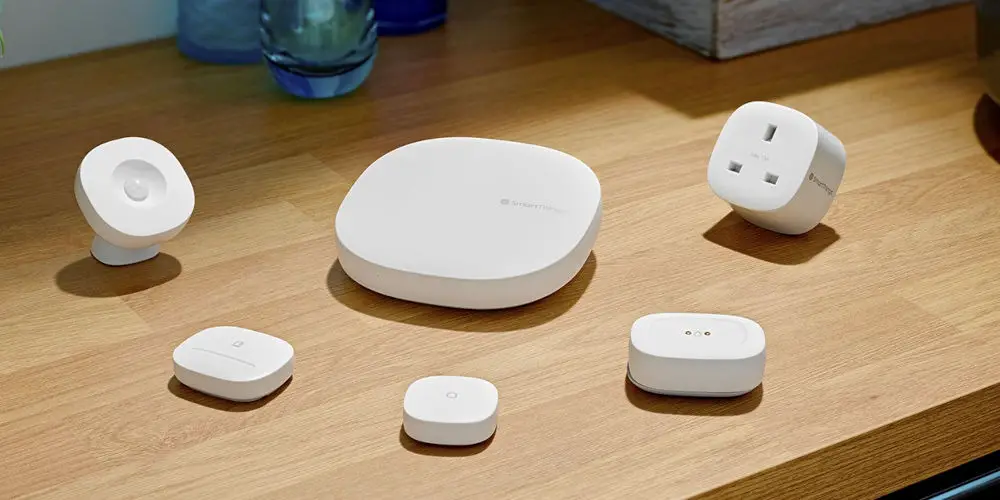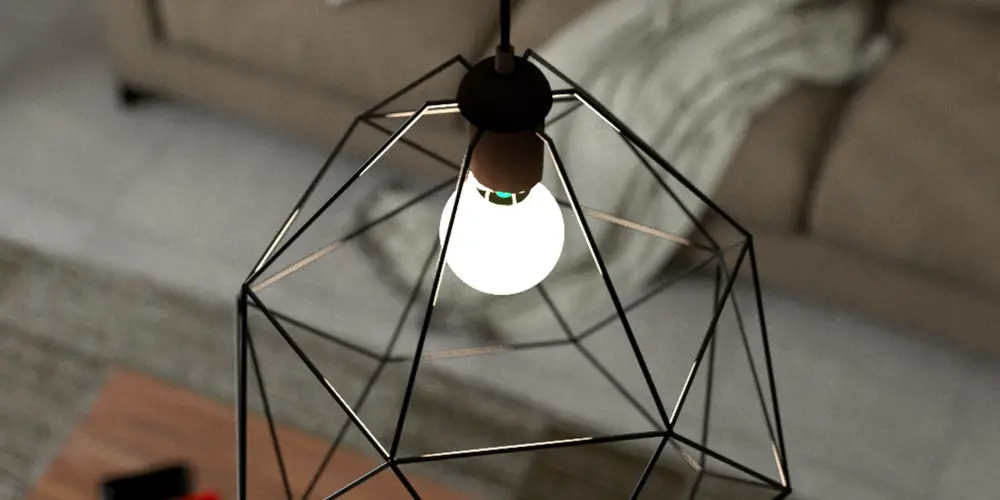How to decide between Z-Wave vs Samsung SmartThings

Adding a home automation system to your property is an exciting journey. However, it’s easy to become frustrated at the sheer number of options available. So, you might want to compare two of the top smart home brands; Z-Wave vs Samsung SmartThings.
The Z-Wave technology has been around for 20 years and is now used in over 4,000 products. You can easily automate your home using Z-Wave, including lights, power, heating, home cinema, and even the equipment that controls your swimming pool.
SmartThings started as a response to a flooded second home, whose owner realised there weren’t any affordable and flexible options for automating a home. A few short years later, Samsung purchased the company and started to roll the technology into their products.
It might seem that the two are wildly different. However, both use the Z-Wave protocol, making it even more difficult to choose between Z-Wave vs Samsung SmartThings.
That said, the SmartThings system also works with the Zigbee protocol, expanding your options even further.
To fairly compare Z-Wave vs Samsung SmartThings, we’ll look at each system in detail, exploring what it can offer and its limitations. Next, we’ll try to draw a fair comparison between the two, allowing you to make an informed buying decision.
By the end, you’ll know if Z-Wave vs Samsung SmartThings is the right option for you and your home.
Z-Wave

Various Z-Wave devices
History
Dating way back to 2001, Z-Wave is 20 years young! Created by a Danish company named Zensys, the Z-Wave protocol is a unique way to control the home.
Zensys started building a lighting control using the protocol. Over the years they developed a proprietary chip that enables control via a Z-Wave system. Then they set about to licence the chips, which is now used by hundreds of brands.
To put into perspective how impressive Z-Wave is. In 2005, only 6 products used this technology. Fast forward to 2018, and the number is well over 2,000. Just a few short years later, and the number is closer to 4,000.
How Z-Wave works
At the heart of the system is a proprietary system on a chip (SoC). This uses an unlicensed frequency band in the 900 MHz range. The protocol has a much bigger range than Bluetooth and is a lower power alternative to Wi-Fi.
In simple terms, Z-Wave uses a mesh network where each device can talk to each other. As devices talk to each other, they can repeat messages and also acknowledge they’ve received messages.
As devices have a 30-metre range, the network can adapt itself to ensure signals are routed in the best possible way to avoid any ‘dead-spots’.
Is it DIY friendly?
While there are some retrofit products on the market, most devices are plug-in and play. This means anyone can easily install and configure a Z-Wave system. Although you do need to pair devices to allow them to work as part of a system.
Current products
With over 4,000 products, there’s likely a product to control almost every function in your home and garden!
Some brands, for example, Fibaro offer a complete solution with a hub, app, sockets, and heating control that’s built around the Z-Wave framework yet operates as a complete stand-alone system.
There’s a range of controllable light bulbs that work with Z-Wave. These include screw-in lighting and dimmer sockets. Fibaro, for example, produces modules that sit behind the existing light switch in its backbox.
Also, you can easily buy Z-Wave power sockets, sensors, relays and controllers. There’s even a Yale Z-Wave door lock that uses both traditional keys and a keypad.
If you’re looking to control heating, there’s a range of products for that. You can replace your thermostat with a smart one or upgrade your TRVs to smart devices, allowing you full control over the heating in each room.
There are even robotic vacuum cleaners, robomowers and a few smart appliances that work with Z-Wave!
Downsides
There are very few downsides to Z-Wave. While only limited retrofittable products are available, the market does seem to be shifting in this direction. Plug-in-and-play devices are easy to install but stick out and can look quite ugly.
In theory, the Z-Wave protocol ensures all devices with the chip play nicely with each other. However, some can require a bit of work to get them working nicely together. So, you might end up having research and experiment.
Samsung SmartThings

photo by Samsung
History
After experiencing extensive damage to his Colorado mountain home due to a power outage, co-founder Alex Hawkinson reasoned that it could have been avoided by using the right technology. As he couldn’t find a suitable solution, Hawkinson decided to solve his problem by starting SmartThings.
Just a few short years later and Samsung acquired the start-up for $200 million. Many considered this acquisition as Samsung first move into the Internet of Things (IoT) space and a small indication of the brand’s future direction.
Now known as Samsung SmartThings, the system provides customers with a fully integrated and automated home solution. Since the system is backed by Samsung, they have started to roll the SmartThings technology into various products.
How does Samsung SmartThings works?
At the heart of the Samsung SmartThings system is a hub, which connects to your Wi-Fi router, allowing you control from anywhere with an internet connection using the SmartThings app or website.
The hub sends and receives commands to devices and can be linked with up to 231 units. You can easily build a system that controls your lights, curtains, power, heating and TV.
What makes the system unique is Samsung now offers a range of products with the technology built-in, allowing for easy smart home integration. For example, you can buy a washing machine or robotic vacuum with the SmartThings technology already built-in.
But that’s not all. Another feature that makes the Samsung SmartThings system incredible powerful is that it also works with any Z-Wave or Zigbee device. So you’re able to use thousands of 3rd party products with the system.
If you want to be able to remotely control anything within your home, there will be at least one solution available.
Is it DIY friendly?
Samsung SmartThings is very DIY friendly and easy to install. It’s also highly affordable. The majority of devices are plug-in and play, allowing you to be set up and running in minutes.
Current product range
Easily automate your home by using a hub and a few plug-in-and-play power sockets. Once installed, it takes about a minute to pair devices with the hub.
Currently, Samsung doesn’t offer bulbs or light switches. That said, you have a range of options, including Zigbee light bulbs and Philips Hue range. Both work painlessly with SmartThings.
Partnering with Honeywell and Natamo, SmartThings offers two heating control options depending on your budget and level of functions required.
An area where Samsung SmartThings excels is security. The product range includes several sensors that can detect motion, water and opening door/windows. There are also smart security cameras and a smart doorbell, which has a built-in camera and two-way audio.
Many Samsung products now include the SmartThings technology. For example, Any Samsung TV released since 2016, is likely to integrate into your SmartThings system or even act as the hub. No other smart home brand offers thing level of integration.
Following this success, Samsung has started to roll out products with SmartThings built-in including a Blu-ray player, soundbars, washing machine and robotic vacuum.
In terms of control, you can use either an app (both iOS and Android versions available) and a dedicated website. If you’re already using a Galaxy phone, then you can use Bixby to control your smart home with voice commands. You can also use the Samsung SmartWatch.
Are there any downsides?
As with other smart home systems that use Wi-Fi, some users have experienced drop-outs or poor signals. Often, this is due to the position of the hub or the wall thickness. However, you can boost the signal by adding a secondary hub.
Pairing devices can be tricky as not all products are found by the hub on the first try. Usually, this is a temporary problem that sorts itself out after a few attempts. If you fail to properly or fully remove a device’s pull tab, you can have issues pairing devices.
While they offer superb customer service, app updates can be quite buggy, leading many users to roll back to a previous edition until Samsung release fixes.
Unlike some home automation systems, which use aesthetically pleasing retrofittable devices, the Samsung SmartThings uses plug-in and play devices that stick out. That said, these are easy to install and don’t require you to rewire anything.
Z-Wave vs Samsung SmartThings
Having looked at both of the systems in detail, you might wonder how Z-Wave vs Samsung SmartThings compares. Let’s take a look.
Samsung SmartThings
It’s easy to see the appeal of SmartThings. Firstly, the Samsung name holds much influence over home technology products with many of us having or using at least one of their products in our home.
While it doesn’t offer the programming options of Z-Wave, SmartThings is easier to install as many devices are plug-in and play. Great if DIY isn’t your thing! That said, it does offer voice control using Samsung’s Bixby app as well as a dedicated app and online portal.
The real magic of SmartThings isn’t the product range. What makes SmartThings very interesting is that Samsung has started to roll out the technology across its product range, providing the consumer with an easier route to building a smart home.
Other big electronic brands may offer compatibility with Z-Wave, Google Home or Amazon’s Alexa but none offer products with their propriety home automation technology already built-in.
Z-Wave
As an open system with over 4,000 products available, Z-Wave can be as simple or complex as you need to. These affordable products are available worldwide. So, no matter where you are, you can use Z-Wave in your home.
As the system uses two-way communication forming a mesh, the system range is good. It’s superior to other DIY home automation systems. And as Z-Wave uses a unique protocol, it doesn’t slow down your Wi-Fi.
Z-Wave largely uses plug-in and play devices, a factor we dislike purely from an aesthetic point. However, more companies are releasing devices that can replace existing ones, creating a more attractive finish.

Choosing a winner: Z-Wave vs Samsung SmartThings?
What makes comparing Z-Wave vs Samsung SmartThings tricky is they both use the same underlying technology. However, SmartThings can also work with ZigBee devices. Plus, many Samsung products have the technology built-in, allowing seamless integration.
That said, the Samsung SmartThings product range alone leaves much to be desired as it’s very basic and limited. Compare this to the 4,000 or so devices that work with Z-Wave, and you’ll want to use the latter.
Another element to consider is how flexible each system is to programme. Both systems work with IFTTT, allowing you to control third-party devices and create complex sequences. However, the majority of Z-Wave systems offer superior programming capabilities over SmartThings.
The big draw of SmartThings is that many Samsung products have the technology built in. You can easily control appliances using your phone or tablet without any headaches or hassle, thanks to SmartThings.
If Samsung is your favourite brand of electronics, SmartThings might be the best option. Otherwise, invest in Z-Wave and use IFTTT to control devices that use a different protocol.
Hopefully, that helps you to decide between Z-Wave vs Samsung SmartThings.




